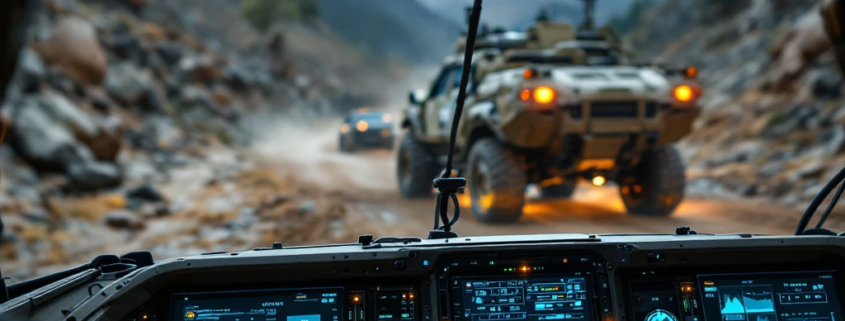How Does CAN Technology Improve Military Vehicle Performance?
Controller Area Network (CAN) technology revolutionizes military vehicle performance by enabling robust, real-time communication between multiple electronic systems. This standardized protocol allows for efficient data exchange between critical components like engines, weapons systems, and sensors while reducing wiring complexity. The military-grade implementation offers enhanced resilience against harsh battlefield conditions, electromagnetic interference, and potential system failures. With its fault-tolerant architecture and secure communication capabilities, CAN technology serves as the backbone for modern defense vehicle electronics, significantly improving operational reliability and tactical responsiveness.
What is CAN technology in military vehicle applications?
Controller Area Network (CAN) technology represents a specialized communication protocol that allows multiple electronic control units (ECUs) to interact without requiring a host computer. Originally developed in the 1980s by Robert Bosch GmbH for civilian automotive applications, this technology has been adapted and hardened for military environments to meet stringent defense requirements.
CAN operates as a message-based protocol, utilizing a multi-master serial bus where all connected units can transmit and receive data. In the military context, this architecture enables seamless integration of various vehicle systems—from powertrain management to weapons controls, surveillance equipment, and communication devices—creating a unified electronic ecosystem.
The significance of CAN in modern military vehicles cannot be overstated. By replacing traditional point-to-point wiring with a shared communication network, CAN technology reduces overall system weight, complexity, and potential points of failure. This is particularly valuable in military applications where vehicles must perform reliably under extreme conditions while carrying substantial electronic payloads.
Military-specific CAN implementations feature ruggedized components, enhanced error detection mechanisms, and modified protocols to accommodate the unique demands of battlefield operations. These specialized adaptations ensure continued functionality in environments characterized by extreme temperatures, vibration, dust, moisture, and potential electronic warfare threats.
How does CAN technology enhance military vehicle reliability?
The fault-tolerant architecture of CAN technology serves as a critical foundation for military vehicle reliability. Unlike traditional systems where a single point of failure could disable entire functions, CAN networks continue operating even when individual components malfunction, ensuring mission-critical systems remain available during combat operations.
CAN employs sophisticated error detection mechanisms that continuously monitor message integrity. When transmission errors occur, the system automatically identifies corrupted data and initiates retransmission protocols. This self-healing capability is essential in battlefield environments where electronic systems face interference from various sources.
The redundancy capabilities built into military CAN implementations allow for duplicate critical systems to operate simultaneously. Should the primary system encounter difficulties, secondary systems can seamlessly take over with minimal operational disruption. This redundancy extends to the physical layer, where dual-channel configurations provide backup communication pathways if primary channels are compromised.
During partial system failures, CAN networks maintain essential functions through priority-based message handling. In military vehicles, this means that vital systems like engine management, steering controls, and defensive capabilities remain operational even if less critical systems go offline. This prioritization ensures that soldiers can continue basic operations and potentially extract the vehicle from dangerous situations despite subsystem failures.
CAN technology’s reliable performance in extreme conditions is demonstrated by its continued operation in temperature ranges from -40°C to +125°C, making it suitable for deployment across diverse global military theaters—from arctic environments to desert conditions. The system’s resistance to shock, vibration, and moisture further enhances vehicle reliability in combat zones where environmental stressors are severe and unpredictable.
Why is CAN technology preferred for military communications systems?
The robust security features of CAN technology make it an ideal choice for military communications systems. While the base protocol was not designed with military-grade security in mind, defense implementations have incorporated advanced encryption layers, authentication mechanisms, and intrusion detection systems. These enhancements protect sensitive operational data from interception or tampering attempts.
CAN’s inherent resistance to electromagnetic interference (EMI) provides crucial protection against both unintentional radio frequency disruptions and deliberate electronic warfare attacks. Military vehicles equipped with CAN technology can maintain reliable communications even in electromagnetically contested environments, where jamming devices or electromagnetic pulses might be deployed by adversaries.
The real-time data capabilities of CAN networks allow for near-instantaneous transmission of critical information between vehicle subsystems. This deterministic communication ensures that command and control messages are delivered with predictable timing—a requirement that can mean the difference between mission success and failure in fast-paced combat scenarios.
When compared to alternative technologies, CAN offers compelling advantages for military applications. Ethernet-based systems provide higher bandwidth but lack CAN’s deterministic messaging and fault tolerance. FlexRay offers higher speeds but at increased complexity and cost. LIN (Local Interconnect Network) is simpler but lacks robustness for mission-critical functions. CAN strikes an optimal balance of reliability, simplicity, and performance for military vehicles where consistent operation takes precedence over maximum data throughput.
The compatibility of CAN with military-grade encryption standards enables seamless integration with broader tactical communication networks while maintaining appropriate security levels. This interoperability ensures that vehicle systems can securely exchange information with command structures and other platforms in the battlefield information ecosystem.
Key takeaways about CAN technology in military applications
The implementation of CAN technology in military vehicles delivers substantial performance improvements through streamlined electronic architecture, enhanced system reliability, and secure communications. These benefits translate directly to increased operational effectiveness, reduced maintenance requirements, and improved soldier safety in combat environments.
Future development directions for military CAN systems include higher bandwidth variants such as CAN FD (Flexible Data-Rate), enhanced cybersecurity features, and greater integration with autonomous vehicle technologies. These advancements will further extend the capabilities of military vehicles while maintaining the robust foundation that makes CAN technology valuable for defense applications.
At TKE Sweden AB, we leverage over two decades of expertise in CAN-bus technology to provide defense clients with customized solutions that meet the unique challenges of military environments. Our understanding of both the technical requirements and operational context allows us to develop systems that perform reliably under the most demanding conditions.
For military organizations considering CAN implementation, key practical considerations include compatibility with existing systems, appropriate redundancy levels, environmental hardening requirements, and security protocols. The modular nature of CAN technology allows for phased implementation approaches, enabling gradual upgrades of vehicle electronics without complete system overhauls.
As battlefield technology continues to evolve, CAN networks will remain a cornerstone of military vehicle electronics, providing the reliable communication infrastructure necessary for increasingly sophisticated defense systems. With appropriate expertise and implementation strategies, defense organizations can maximize the performance benefits of this proven technology while preparing for next-generation capabilities.
Curious how automation enhances defence systems?
Dive into our defence case studies to learn how scalable CAN-based solutions improve reliability, safety, and performance in mission-critical environments.



